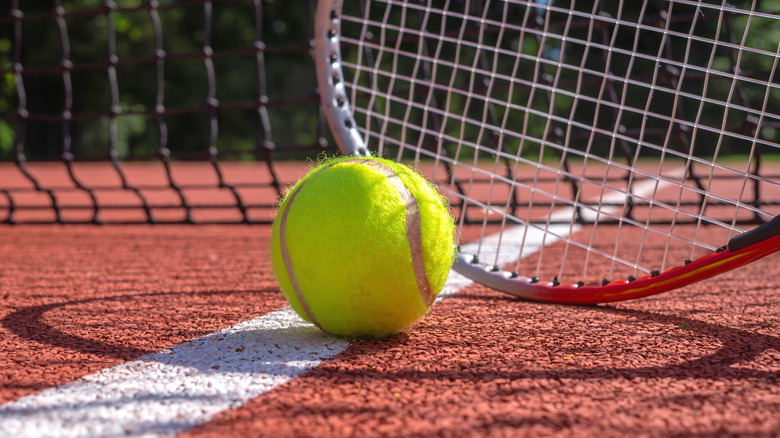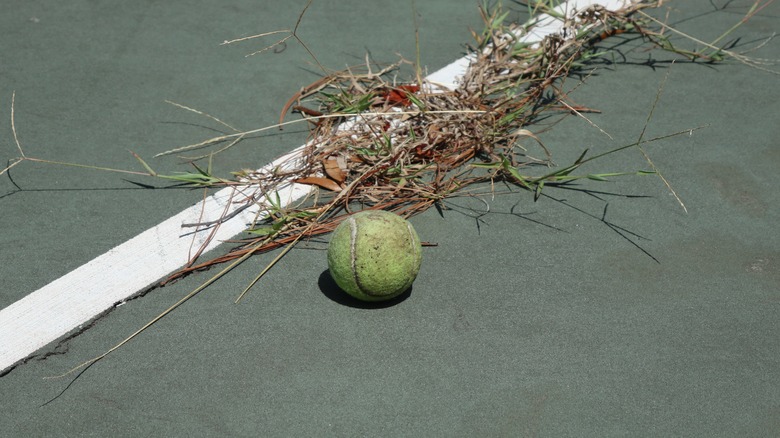Does Having A Tennis Court Add Value To Your Home?
If you've always idolized Roger Federer's silky backhand or spent your childhood marveling at the achievements of the Williams sisters, then you probably don't need much of a compelling reason to build a tennis court on your property. For those who love the game and have the resources, the luxury of having a personal court, available 24/7, is something they are willing to pay considerable sums to obtain, according to The Agency.
A tennis court is a costly investment — anywhere from $25,000 to $120,000 for installation per Angi, while maintenance averages out at $1,800 annually (via Bankrate). The costs vary, depending on the surface, size, and the original condition of the land. But this added investment also translates into property value for the right buyer. Moreover, the court itself has uses beyond tennis, for example as a flat area that can be used as a base for wedding marquees.
However, a tennis court isn't an automatic value-add to a home. According to Mansion Global, if it's a choice between a tennis court, a pool, or a grassy outside space, a court comes third on the priority list. Smaller properties can be overwhelmed by the court, and because of the upkeep, it's best to only think about installing one if you actually want to use it, rather than any potential payout, according to Express. However, recent events have made certain tennis courts a more secure investment.
The socially distanced game
A resurgence of interest in the game of tennis has followed the COVID-19 pandemic. The game is intergenerational, is easy to play socially distanced, and in warm areas with low rainfall, it is a year-round activity, notes The West Australian. Having access to a home court is also incredibly desirable in areas like Australia that had strict lockdowns, and people who want unfettered court access are now sure to include it on their property wishlist.
Los Angeles is another market that has seen a boom in the prestige of tennis courts since 2020. The year-round sunshine, combined with the cachet of having more room to roam has seen a reversal of fortune for tennis courts, which were on the decline in Southern California in recent decades, according to The Hollywood Reporter.
It's clear that the value of a tennis court comes down to the unique context of your property, and even down to each potential buyer's interest in it as a feature. In the UK, for example, it is estimated that a tennis court can add 22% to the value of a home. However, most people still advise thinking of a tennis court as an investment in your family's lifestyle, rather than a financial gambit, according to Attwaters Jameson Hill.
Tennis court upkeep
Tennis courts can be made of various materials, and each performs differently in play as well as after being subjected to years of wear and tear. The average installation costs, according to Angi, range from $25,000 for a cheap grass court install, through around $50,000 for an asphalt or post-tensioned concrete surface, to almost $100,000 for a concrete or asphalt base and a premium acrylic top layer.
Acrylic surfaces require little upkeep and have a long lifespan, which is why they cost the most. Grass and clay both require regular watering, cutting, or raking, additionally clay and asphalt courts require $1,000 to $2,000 for annual upkeep. This is because their surface needs periodically replacing — an asphalt court will need replacing every 4 to 8 years and costs $4,000 to $8,000 dollars, according to SportMaster.
The important point about tennis court upkeep isn't the cost, though. Courts that are easy to maintain as long as you aren't negligent. According to World Tennis, signs of wear and tear, flooding, surface damage, or plant infestations can be avoided just by spending time on the court and paying attention. And let's face it — if you're actually getting some use out of your court, the inevitability of spending money on its upkeep feels like less of a problem.


